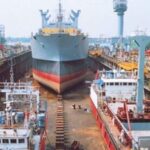India will provide additional incentives to encourage domestic shipyards to develop fuel-efficient and technologically advanced vessels as part of its ambitious plans to transform the country’s shipping industry.
The ports, shipping, and waterways ministry is finalising a cabinet note to provide a 25% subsidy for specialized vessels, and up to 30% for green vessels and other highly specialised ships, according to two persons aware of the matter.
These subsidies will be provided under the government’s ₹18,000 crore shipbuilding financial assistance policy (SBFAP) 2.0, they said.
This policy will replace SBFAP 1.0, which was launched in 2016 for a 10-year period to incentivize shipbuilding. Under SBFAP 1.0, financial assistance provided to Indian shipyards for shipbuilding contracts was slashed from 20% in 2016 to 11%.
The shipping ministry has defined green vessels as those run on biofuels, methanol, ethanol or electricity. Highly specialised ships such as hydrogen-powered vessels use advanced propulsion technologies that reduce emissions while delivering more power.
The additional shipbuilding incentives are part of the government’s ambitions to develop India’s blue economy, or the sustainable use of ocean resources, and position the country as a ship-manufacturing hub. India currently has less than 1% of the global shipbuilding market, which is dominated by China, South Korea, and Japan.
Also read | Govt plans incentives, ban on foreign vessels to boost local shipbuilding
Subsidies under the new policy will be based on the contracted price of a vessel, or the fair value determined by the government, for ships manufactured at an Indian shipyard, said one of the persons mentioned above.
This person added that the level of financial assistance will be maintained throughout the scheme’s duration, likely until 31 March 2034.
The second person said the shipping ministry has estimated an initial budgetary requirement of ₹18,000 crore for SBFAP 2.0.
“Domestic shipbuilding will help achieve the government’s target of controlling at least 5% of global tonnage,” said Pushpank Kaushik, chief executive of Jassper Shipping, a Hyderabad-based global shipping and logistics firm.
“Presently, we have less than 1% of global tonnage and it is not enough to achieve the targeted economy growth and development of the nation. Domestic shipbuilding will not only support Indian ship owners but will also become an alternate shipbuilding destination away from Vietnam, Korea, Japan and China,” he said.
The ministry of ports, shipping and waterways did not reply to emailed queries.
Also read | For India’s shipping industry, a new rule promises to be a game-changer
An ambitious target
The updated shipbuilding financial assistance policy will target increasing the percentage share of India-built ships in India’s fleet from 5% now to 7% by 2030 and 69% by 2047.
As of December 2023, India had a fleet strength of 1,530 vessels with gross tonnage of about 14 million, marginally up from a fleet strength of 1,520 vessels and 13.69 million GT at the end of 2022, per the shipping ministry’s data.
But about 44% of India’s merchant shipping fleet is above 20 years of age, 13% is 16-20 years, and 20% is 11-15 years—indicating potential for replacing these ships over the next few years.
Also, Indian shipyards have been attracting large orders from overseas markets, including from traditional shipbuilding nations such as Norway, Germany and the US. Indian shipbuilders are also close to striking deals with companies in the Netherlands, Denmark and West Asia.
Another key proposal for the new policy is to issue credit notes worth 40% of a ship’s fair scrap value. The credit note can be reimbursed against the cost of constructing a new vessel at an Indian shipyard.
Also read | Shipping may get infra tag in boost for shipbuilding, vessel owners
“Indian shipyards face a significant cost disadvantage compared to foreign competitors, driven by higher material and financing costs,” said Manish R. Sharma, partner and leader–infrastructure, transport and logistics, PwC India.
“Interest rates in India are often higher than in competing nations like China and South Korea, making Indian shipbuilding less competitive. These issues should be addressed in any policy the government formulates on shipbuilding.”
Mihir Shah, partner, transport and logistics, EY India, had a similar opinion. “The new policy of the government should recognise the need to fast-forward the growth agenda for the shipbuilding and ship repair industry in India,” he said. “Lessons learnt from the implementation of SBFAP and other related initiatives should be analysed while formulating measures under the new policy to drive demand and capacity augmentation.”
Catch all the Industry News, Banking News and Updates on Live Mint. Download The Mint News App to get Daily Market Updates.
MoreLess










